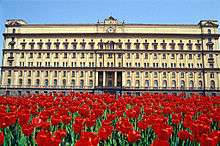Heinrich Scherhorn
Heinrich Gerhard Scherhorn (1897–?) was a German officer in World War I and World War II. On March 23, 1945 he received the Knights Cross of the Iron Cross (Ritterkreuz des Eisernen Kreuzes).
Youth and First World War
Scherhorn was born in 1897 in Apelern, Schaumburg, Lower Saxony. In 1913, he graduated from Scharnhorst High School (Gymnasium) and joined the Imperial Army as an Officer Cadet. During the war, he was promoted to lieutenant and was awarded the Iron Cross 2nd Class for bravery. Wounded twice, he was made a prisoner of war by the French in 1918. In 1919, after the Armistice, he was repatriated.
Second World War
Serving as a Major at the outbreak of World War II in 1939, he was head of the personnel department of the military recruiting station Hanover County. From 1943 on, he served in the headquarters of the 286th Sicherungs Division. In the same year, he was promoted to lieutenant colonel. On June 20, 1944 was appointed commander of the Sicherungs-Regiment 36 and won the Military Merit Cross with Swords 2nd Class and the Iron Cross 1st Class.

In 1944, when the German Army Group Center (Heeresgruppe Mitte) was crushed, Scherhorn was made prisoner of war by the Soviets near Minsk. As a staff officer speaking French and English besides German, he came to the attention of the NKVD and, as a special case, was brought to central prison camp 27/1 in Moscow. Kept in solitary confinement in the infamous Lubyanka prison and constantly interrogated, he was given the choice of either cooperating with the NKVD or face charges for alleged war crimes due to the fact, that his regiment had performed anti-partisan duties.
Operation Berezino-Operation Scherhorn
From August 1944 to May 1945 Scherhorn cooperated with Soviet intelligence service under the agent alias Shubin in one of the major Soviet counterintelligence operations of the war, named "Operation Berezino" in Russian, masterminded by General Pawel Sudoplatov and Colonel Leonid Eitingon, both NKVD and both involved with the assassination of Trotsky in Mexico in 1940.
The legend the Soviets built, was the illusion that Scherhorn, commanding a cut off battle group of approximately 2500 men, asked for air supply by radio, to enable him to break out and reach the German front line. The NKVD operatives calculated, that the German High Command (Oberkommando der Wehrmacht) could and would not ignore such a large number of soldiers and would try their best to supply them, thus drawing attention and manpower as well as supplies from the Germans and reduce their possibilities to supply other, smaller, existing pockets.

From August 1944 to May 1945 the Soviets kept the deception going, not just by radio but with a fake German resistance pocket on the ground, manned by German communists and prisoners of war. Scherhorn, of course closely watched at all times had to play along, creating credible action and situation reports.
In Germany, the task of supplying Scherhorn by air was given to Otto Skorzeny's special units and the Luftwaffe KG 200 and was named "Operation Freischütz". Under great risk, ammunition, provisions and specialists, especially radio personnel, were flown in during the night and dropped on the waiting Soviets, thus enabling them to use the newest German cyphers and equipment. For successfully fighting behind enemy lines, Scherhorn was awarded the Knight's Cross of the Iron Cross and promoted to Full Colonel on March 23, 1945 while in fact being in Soviet captivity. Scherhorn's last radio contact was on occasion of the German unconditional surrender on May 9, 1945.
Later life
Scherhorn was released by the Soviets in 1950 and repatriated. Back in Germany, he was active in several veteran organizations and refused to accept the Knight's Cross.